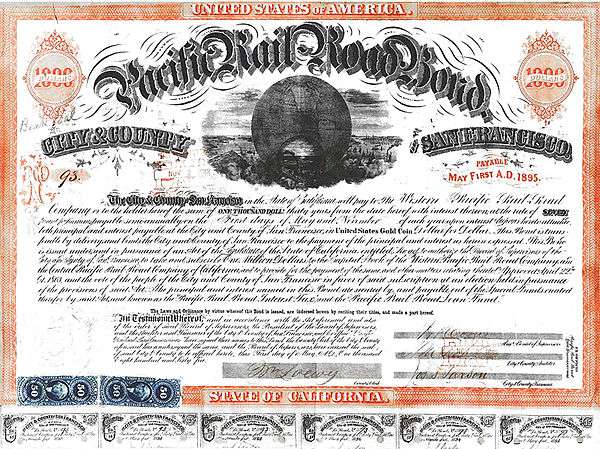Western Pacific Railroad (1862–70)
| Locale | Western Pacific Railroad |
|---|---|
| Dates of operation | 1864–1870 |
| Predecessor | Central Pacific Railroad |
The Western Pacific Railroad was formed in December, 1862, by a group led by Timothy Dame and including Charles McLaughlin and Peter Donahue, all associated with the San Francisco and San Jose Railroad, to build a railroad from San Jose north to Vallejo's Mills (mouth of Niles Canyon, later Niles, now part of Fremont), east through Niles Canyon, north to Dublin/Pleasanton, east through the Livermore Valley, and over Altamont Pass to Stockton, then north to Sacramento,[1] with the plan that the transcontinental railroad would follow the Western Pacific to San Jose and then the San Francisco and San Jose to San Francisco. In October, 1864, the Central Pacific Railroad assigned all the rights of the Pacific Railway Acts of 1862 and 1864 to the Western Pacific for the route between Sacramento and San Jose, including land grants.[1] In 1866, the first twenty miles from San Jose had been completed when funding problems halted construction within Niles Canyon. Part of the difficulty was that federal land grants were not available where Mexican land grants had previously been made.

By 1867 the Central Pacific had decided that the route via San Jose to San Francisco was too long and that it would be better to change to a route using ferryboats from the CPRR's Oakland Pier in Oakland.[2][3] To reach Oakland a CPRR subsidiary bought the Western Pacific, owned at that time by Charles McLaughlin and William Carr.[1] Construction started again in the spring of 1867 and included a line from Vallejo's Mills toward Oakland.[4] The CPRR briefly considered a shorter route west from Dublin/Pleasanton to the Hayward/San Leandro area (a route later built by Bay Area Rapid Transit), but decided that the grades were too much of a disadvantage compared to the Niles Canyon route.[4] The railroad was completed in 1869 to San Leandro, where it joined the San Francisco and Alameda Railroad.
The Western Pacific operated a total of ten locomotives. The first five were built in 1864 by the Norris Locomotive Works plant at Lancaster, Pennsylvania. One of these was a 12-ton 4-2-0 while the others were of the more conventional 4-4-0 type weighing from 30 to 33 tons. Baldwin Locomotive Works of Philadelphia built three more 30-ton 4-4-0 locomotives in 1866, and two similar locomotives were built by Mason Machine Works of Massachusetts in 1867.[5]

The first transcontinental train to reach San Francisco Bay arrived at the SF&A RR's Alameda Pier on September 6, 1869 and the passengers took the SF&A RR ferryboat to San Francisco.[3][6] Two months later the rail connection to the San Francisco and Oakland Railroad was in place and the transcontinental trains now ran through Oakland to Oakland Pier.[3] In 1870 the Western Pacific Railroad was absorbed into the Central Pacific Railroad.[7] In 1879, the CPRR shortened its route from Sacramento to Oakland further by putting together a line from Sacramento to Benicia, crossing by very large train ferries to Port Costa, and then along the south shore of Carquinez Strait and San Pablo Bay to Richmond, Berkeley, and Oakland to Oakland Pier.[8] From then on, the Altamont Pass route was a secondary route between the East Bay and the San Joaquin Valley.
In 1903 a new Western Pacific Railroad was formed to build a line between Oakland and Salt Lake City, including a branch to San Jose. Its routes between Sacramento, Oakland, and San Jose closely paralleled the tracks of the original Western Pacific Railroad, then belonging to the Southern Pacific Railroad. In 1979, the SPRR obtained trackage rights over the Western Pacific Railroad, and then abandoned its own track over Altamont Pass to Niles except for the track through Niles Canyon which was obtained by the Niles Canyon Railway, a museum railroad. Other sections of the original Western Pacific route, to Stockton and Sacramento, to Oakland, and to San Jose remain as part of the Southern Pacific Railroad.
References
- Daggett, Stuart (1922). Chapters on the History of the Southern Pacific. New York: The Ronald Press. "Mcloughlin" should be "McLaughlin" and "Dane" should be "Dame".
- Due, John F. (December 1956). "The San Francisco and Alameda Railroad". Pacific Railway Journal. San Marino, California: Southern California Chapter, Railway & Locomotive Historical Society and the Pacific Railroad Society. 1 (11): 2–8.
- Ford, Robert S. (1977). Red Trains in the East Bay: The History of the Southern Pacific Transbay and Ferry System. Interurbans Specials. 65. Glendale, California: Interurbans Publications. ISBN 0-916374-27-0. McLaughlin rather than Donahue took the lead in selling the WP RR.
- Pacific Railway Commission (1887). Report of the United States Pacific Railway Commission (and Testimony Taken by the Commission). VIII. Washington. D.C.: Government Printing Office. pp. 4568–4578.
- Root, Henry (1921). "3, Central and Southern Pacific Railroad Work in Oakland, San Francisco and Elsewhere". Henry Root: Surveyor, Engineer, and Inventor; History and Reminiscences with Personal Opinions on Contemporary Events, 1845-1921. San Francisco: Printed for Private Circulation.
External links
| Wikimedia Commons has media related to Western Pacific Railroad (1862–1870). |